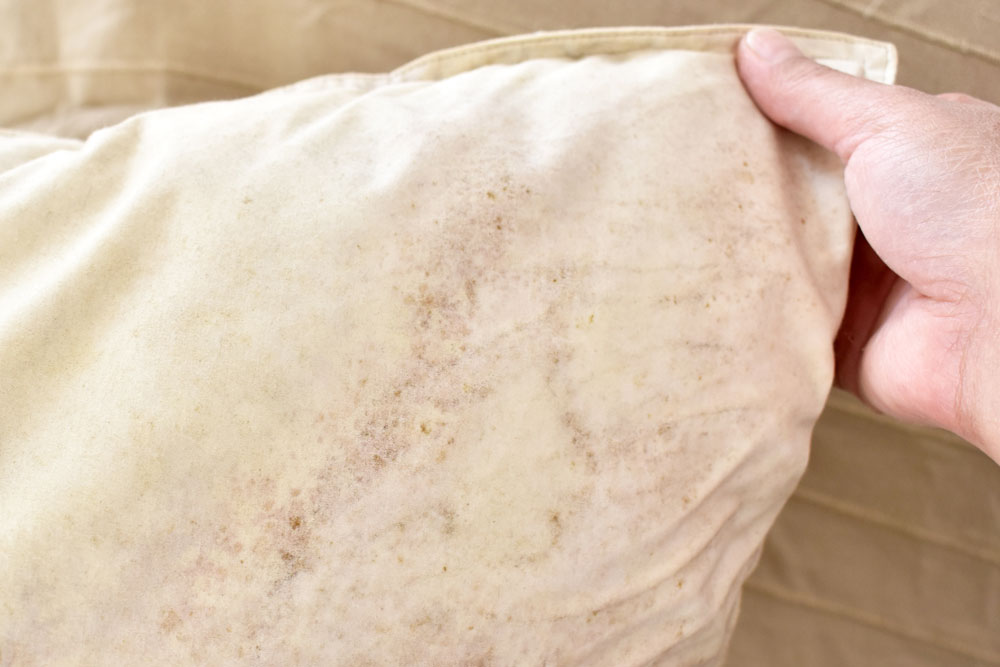How To Clean Mould Off Fabric
 CONTENTS
CONTENTS
- What causes mould to grow on fabric?
- The effects of mould growth on fabric
- How to get mould off fabric
- How to prevent mould on fabrics
- Book your mould remediation today
If mould starts growing on your clothes or upholstery, you must act quickly and have it removed. Not only can it discolour your garments and possessions, it can cause damage and even lead to health problems.
Here at ICE Cleaning, we offer thorough, long-lasting mould removal services. Our fully trained technicians are available nationwide, 24/7, 365 days a year. If it's an emergency, they can be on site within a matter of hours.
Keep reading to find out what you should do when mould starts growing on your fabric.
What causes mould to grow on fabric?
Mould, a type of fungus, flourishes in areas that contain excess moisture such as damp and high humidity. It feeds off organic materials, including the cellulose found in fabrics like cotton or linen, so it can quickly grow and spread on such materials.
Damp clothing left unattended or stored improperly can become an ideal breeding ground for these spores. But it's not just about dampness; temperature plays its part, too.
Ambient temperatures between 20-30°C are most conducive to mould development. These conditions often exist inside wardrobes and closets, especially those that lack proper air flow.
Closets and wardrobes tightly packed with clothes leave little room for fresh air to come in and get rid of pockets of humid air, too.
Upholstery is also vulnerable to mould growth, particularly if it gets wet, or is stored in a damp or humid space. Fabric chairs and sofas left too close to walls mean humid pockets of air can get trapped behind them, making the area damp and encouraging mould growth.
Fabric blinds and curtains are especially vulnerable to mould growth due to their proximity to windows and windowsills which are hotspots for condensation formation and mould growth.
The effects of mould growth on fabric
Mould poses a substantial threat to both our health and the integrity of our fabrics. Organic materials like cotton, linen, or silk provide fertile grounds for mould spores. The stains can make your clothes, curtains, and upholstery unsightly and cause them to undergo biodegradation that affects their texture and appearance significantly resulting in irreversible damage.
How to get mould off fabric
Mould removal from any material can be a daunting and dangerous task that is always best left to the professionals. Removing it from porous surfaces like fabric, however, is much more challenging. Mould can grow deep in the pores of the fabric and evade treatments that only tackle surface-level mould.
The incorrect handling of mouldy material, such as washing it on high temperatures or applying harsh chemicals, can cause additional damage to the fabric, too.
The risks associated with cleaning mould off fabric yourself are also significant; it will bring you in closer contact with the mould, and you will be more likely to touch and inhale the spores if you are not wearing the right personal protective equipment.
The benefits of professional mould cleaning
Apart from the expertise in dealing with mould growth on a range of surfaces, including cleaning mould off fabric blinds, professional mould cleaners can safely eradicate the mould in your home.
Our technicians, for example, have many years of remediating mould from domestic and commercial properties. They are fully trained in the latest health and safety procedures, such as covering the affected area during the remediation to ensure no cross-contamination occurs during the process, too.
Our nine-stage mould removal process can eradicate all the mould in the property, even mould in the air, as well.
How to prevent mould on fabrics
Maintaining an environment hostile to mould is crucial. This mainly means controlling humidity, the most common cause of mould.
Invest in a good quality dehumidifier if your home struggles with high humidity to ensure the humidity level stays below 50% all day. You can even buy dehumidifiers for the wardrobe so your clothes are stored in a dry, low humidity area.
Circulation of fresh air can also deter the growth of mould on fabrics by dislodging pockets of humid air. Consider installing vents or fans, particularly in wardrobes, or make sure there is sufficient space between clothes.
Regular cleaning and dusting will remove potential food sources for the fungus - remember that even tiny particles can provide sustenance for spores.
You should ensure there is a gap between furniture and the wall to allow sufficient airflow through the property, too.
To protect blinds and curtains against mould growth, take steps to protect mould growth and condensation formation on windows and windowsills. You can find out more in this blog.
Book your mould remediation today
With every mould removal we offer a lifetime guarantee* so if it comes back after treatment, our technicians will return to site to remove it for free.
To learn more about our mould cleaning services, get in touch on 0208 066 0360 or enquiries@icecleaning.co.uk.
*subject to advisories

Speak with me today,
I’m here to help
By asking you a few questions either via phone or email I can immediately provide a realistic estimation of the cost.
You’re in good company. We’ve cleaned for the following commercial clients… View all

Why choose us?
- Cater to a wide variety of cleaning situations
- Nationwide coverage, available 24/7
- Cater to commercial and domestic clients
- Free survey provided prior to quotation
- Emergency response team
- Offer a bespoke service designed to suit all your needs
- All technicians hold professional health and safety qualifications, including BICSc, IOSH, Dewpoint Professional & Safe Contractor
We’re fully accredited
We place best practise, professional expertise and health and safety at the core of our business. We’re fully compliant with all legal obligations. You can view a list of our accreditations below, or visit our Health & Safety page for more information.











-RGB-small.1707319151.jpg)




















